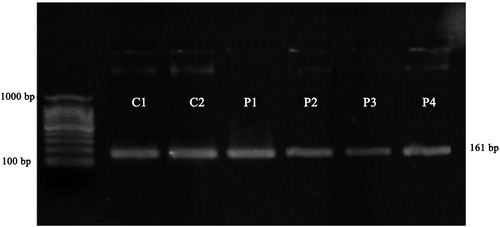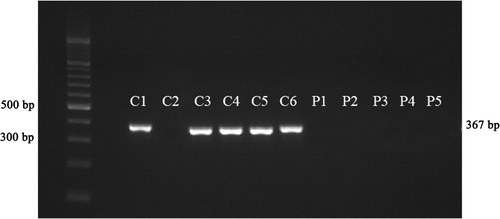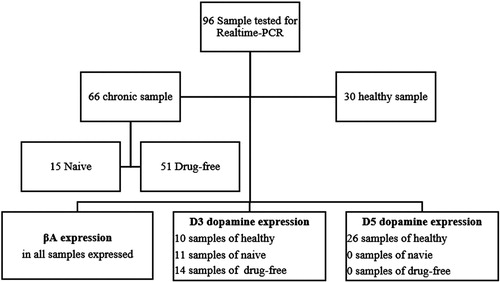ABSTRACT
OBJECTIVE: Schizophrenia, commonly develops in adolescents and young adults and Paranoid is the most common type. Newly progress in molecular biology and imaging techniques has enabled new insight into schizophrenia research. Recent research reveals the key roles of D3, D4 and D5 dopamine receptor in presenting types of schizophrenia, particularly the paranoid. The purpose of this study was to the evaluation of D5 along with D3 dopamine receptor expression in schizophrenia patients.
METHOD: 96 venous blood from 51 drug-free, 15 naive and 30 healthy were prepared and their expression level of mRNA for D3 and D5 dopamine receptor were investigated based on β-actin expression as housekeeping gene.
RESULTS: D3 expressed about 33.3%, 73.3% and 27.4% in healthy, naive and drug-free patients respectively, but D5 just expressed in 86.6% of healthy samples and none of the patients were expressed D5.
CONCLUSION: Expression frequency of D3 and D5 dopamine receptor reveals significant differences between naïve and drug-free patient against healthy individuals. D3 and D5, both have the possible potential for almost more accurate diagnosis usage, and the severity of the disease could be related to the D5 dopamine receptor.
Introduction
Paranoid schizophrenia is one of the most common forms of mental illness that is generally known as schizophrenia. People with all types of schizophrenia suffer from different psychometric behaviours, which cause in lose their touch with the reality. People with paranoid schizophrenia usually have a better chance of recovery than others. This may be because of their relatively healthy cognitive, behavioural, and emotional functioning [Citation1,Citation2]. People with paranoid schizophrenia have significant illusions or frequent auditory illusions. Unfortunately, these psychotic symptoms can have a lot of devastating effects on their performance in the real world [Citation2]. Diagnosis of paranoid schizophrenia defined by two primary symptom and seven sub-features that should present at least four to warrant a diagnosis of paranoid schizophrenia disease which is not certain and accurate for severity level recognition [Citation3].
The earliest approaches in the biology of dopamine receptor and its targeting, signaling cascades and possible opportunities for target therapy with minimum side effect has been investigated [Citation4–6]. Structural and biochemical studies have shown the subtypes of dopamine receptors in one of two groups of receptors D1 and D1b / D5 have a very high homology in domains of their membrane width and similarly retain membrane width sequences among the receptors D2, D3, D4 [Citation7,Citation8]. In terms of pharmacology, D1 and D2 are fundamentally different [Citation9,Citation10]. D1b / D5 receptors stimulate adenylate cyclase and D3 receptors and D4 inhibit adenylate cyclase and subsequently inhibit cAMP formation [Citation11,Citation12].
The aim of this study was to investigate any relevancy and correlation between D3 and D5 receptor expression in the paranoid schizophrenia patients with considering the efficacy of drug used ones. This results would play a key role in the early and accurate diagnosis of paranoid schizophrenia which can predict relapse and symptom severity, and assess treatment effectiveness.
Methods
Patient flow diagram
Flowchart of the cohort of paranoid schizophrenia disease patients and summarizes the process and results ().
Study design
Venous blood prepared from total 96 case study included 66 chronic patients – 15 drug naïve who never received any drug and 51 drug-free who did not receive the drug at least for 3 years – and 30 healthy people enrolled for age and sex match. The patients were in the range of 20–50 year old with from both sexes and did not take any antipsychotic drug, opiate or cigarette/cigar.
The current study was approved in 2014 by the research ethics committee of Tehran University of Medical Sciences in Tehran and participants provided written voluntary informed consent. Patient selection and presenting participant with the paranoid schizophrenia disease for molecular analysis was performed by a clinical psychologist and a senior psychiatry resident based on DSM-V criteria for paranoid schizophrenia disease [Citation3,Citation13].
Quantitation of dopamine receptor RNA
Preparation of blood lymphocyte, RNA extraction and cDNA synthesis performed as Ahmadian S. et al in 2014 [Citation14]. The oligonucleotide primer used for D3 and D5 cDNA synthesis are shown in . Beta-actin (βA) as internal controls were synthesized using a nucleotide synthesizer ().
Table 1. Primer used to cDNA synthesis of the D3, D5 and βA.
Table 2. Primer used to amplify the D3 and D5 and beta-actin.
Quantitative real time-PCR
PCR for both markers was performed by 75 ng cDNA with 5 μl PCR buffer to final volume of 10 µl by light-cycler (Roche, Germany) which followed for D3 as denaturation in 95°C at 10 min for a cycle, amplification in 95, 64 and 72°C at 5, 10 and 30 seconds for 50 cycles, Melting curve 95, 70 and 95°C at 10, 10 and 1 second for a cycle and Cooling in 40°C at 30 second for a cycle respectively. For D5: denaturation in 95°C at 5 min for a cycle, amplification in 95, 65 and 72°C at 30, 5 and 43 seconds for 65 cycles, Melting curve 95, 70 and 97°C at 10, 10 and 1 second for a cycle and Cooling in 40°C at 30 second for a cycle respectively. PCR products were examined by electrophoresis on 1.5% agarose gel containing 0.5 μg/ml ethidium bromide [Citation14].
Statistical analysis
Statistical tests were performed by SPSS software version 11. One-way ANOVA test and repeated measures of ANOVA were used to assess the association between naïve, drug-free patients and healthy controls with beta-actin expression. P-value <0.05 were considered to indicate a statistically significant result.
Results
The expression state of D3 and D5 in compare to βA are as follow:
βA expression: βA mRNA expressed in all samples at 161 bp in agarose gel ().
Figure 2. Quantitative expression of βA mRNA in control (C) and drug-free patients (P1 and P2) and treated ones (P3 and P4).

D3 receptor: Expression state in healthy controls was 33.3% and in naïve and drug-free patients were 73.3% and 27.4% respectively (); which statistical analysis revealed a significant difference between patients and healthy controls for naive drug-free patients.
Figure 3. Quantitative expression of D3 mRNA in control (C) and drug-free patients (P2, P3, P4, and P5) and treated ones (P6, P7, and P8).

D5 receptor: Expression state in healthy control was 86.6% and in drug-free and treated patients were without any expression so the statistical comparison revealed a significant difference between patients and control samples ().
Figure 4. Quantitative expression of D5 mRNA in control (C) and drug-free patients (P1 and P2) and treated ones (P3, P4, and P5).

Almost results did not reveal any correlation between sexes and ages for dopamine expression status.
Discussion
According to the study argued all white blood cells were not eligible for dopaminergic receptors. Only 60% of them represent D3 receptors and 40% represent D4 receptors and all of them expressed D5 receptor cells [Citation15]. In another conducted experiment in South Korea, the expression of D5 receptors in patients who were drug naive, Drug medicated and healthy controls, No significant difference was observed. But the D3 receptor in both naive and non-drug groups showed a significant increase compared to the control group [Citation16]. Ilani in 2001 and colleagues confirmed the results of Kwak, but they also found significant differences in the expression of D3 receptors in the treated group compared to the control [Citation17]. Lipska and colleagues in 2003 evaluated the expression of D1, D2, and D3 receptors in patients undergoing treatment. They did not record any significant changes [Citation18].
In another study, D1 to D4 mRNA expression level was measured and D3 expression level introduced as a reliable marker in early diagnosis assist and follow up study in naive and partly drug-free patients [Citation14], which confirmed our D3 mRNA expression study. As mentioned above, D5 receptors stimulate adenylate cyclase and D3 receptors inhibit adenylate cyclase and subsequently inhibit cAMP formation, so lack of the D5 mRNA expression in treated and drug-free patients is preferred. The lack of expression in a few of healthy controls may be due to the use of any other drugs or medications and alcohol which indirectly influenced the expression of D5 mRNA that did not consider in this research. Zhao [Citation19] revealed that specific SNPs in D5 dopamine receptor-related with paranoid schizophrenia in male; their investigation was on the genetic risk variant association with paranoid schizophrenia disease and found out D5 dopamine receptor gene in both of regulatory and coding region could affect the gene expression which confirmed our results for lack of D5 mRNA expression [Citation19].
Conclusion
Our result suggested lack of D5 dopamine receptor expression level as an auxiliary marker for diagnosis of paranoid schizophrenia and the possibility of its role in severity level could be evaluated by detection of genotype distributions and allele frequencies of GC combined in paranoid schizophrenia patients.
Disclosure statement
No potential conflict of interest was reported by the authors.
References
- Ropper AH, Joshua Klein MAS. Schizophrenia, delusional and paranoid states Adams and Victor's principles of neurology. 10th ed. New York: McGraw-Hill Education; 2014.
- Morrison AK. Cognitive behavior therapy for people with schizophrenia. Psychiatry (Edgmont). 2009;6(12):32–39.
- DSM-V. Diagnostic and statistical manual of mental disorders: fifth edition. Arlington (VA): American Psychiatric Publishing; 2013.
- Aricioglu F, Ozkartal CS, Unal G, et al. Neuroinflammation in schizophrenia: a critical review and the future. Klinik Psikofarmakol Bülteni Bull Clin Psychopharmacol. 2016;26(4):429–437. doi: 10.5455/bcp.20161123044657
- Beaulieu JM, Espinoza S, Gainetdinov RR. Dopamine receptors - IUPHAR Review 13. Br J Pharmacol. 2015;172(1):1–23. doi: 10.1111/bph.12906
- Kose S, Cetin M. The research domain criteria framework: transitioning from dimensional systems to integrating neuroscience and psychopathology. Psychiatry Clin Psychopharmacol. 2017;27(1):1–5. doi: 10.1080/24750573.2017.1293255
- Gingrich JA, Caron MG. Recent advances in the molecular biology of dopamine receptors. Annu Rev Neurosci. 1993;16:299–321. doi: 10.1146/annurev.ne.16.030193.001503
- Hartman DS, Lanau F. Diversity of dopamine receptors: new molecular and pharmacological developments. Pol J Pharmacol. 1997;49(4):191–199.
- Civelli O, Bunzow JR, Grandy DK. Molecular diversity of the dopamine receptors. Annu Rev Pharmacol Toxicol. 1993;33:281–307. doi: 10.1146/annurev.pa.33.040193.001433
- Kulkarni SK, Ninan I. Current concepts in the molecular diversity and pharmacology of dopamine receptors. Methods Find Exp Clin Pharmacol. 1996;18(9):599–613.
- Chio CL, Lajiness ME, Huff RM. Activation of heterologously expressed D3 dopamine receptors: comparison with D2 dopamine receptors. Mol Pharmacol. 1994;45(1):51–60.
- Robertson GS, Fibiger HC. Neuroleptics increase c-fos expression in the forebrain: contrasting effects of haloperidol and clozapine. Neuroscience. 1992;46(2):315–328. doi: 10.1016/0306-4522(92)90054-6
- Vyas A, Khan M. Paranoid personality disorder. Am J Psychiatry Resid J. 2016;11(1):9–11. doi: 10.1176/appi.ajp-rj.2016.110103
- Ahmadian S, Delavari G, Ghanbari D, et al. D3 as a possible marker based on D1-D4 dopamine receptors expression in paranoid schizophrenia patients. J Mol Biomark Diagn. 2014;5(3):171. doi: 10.4172/2155-9929.1000171
- Amenta F, El-Assouad D, Mignini F, et al. Neurotransmitter receptor expression by peripheral mononuclear cells: possible marker of neuronal damage by exposure to radiations. Cell Mol Biol (Noisy-le-grand). 2002;48(4):415–421.
- Kwak YT, Koo MS, Choi CH, et al. Change of dopamine receptor mRNA expression in lymphocyte of schizophrenic patients. BMC Med Genet. 2001;2:3. doi: 10.1186/1471-2350-2-3
- Ilani T, Ben-Shachar D, Strous RD, et al. A peripheral marker for schizophrenia: increased levels of D3 dopamine receptor mRNA in blood lymphocytes. Proc Natl Acad Sci U S A. 2001;98(2):625–628. DOI:10.1073/pnas.021535398 doi: 10.1073/pnas.98.2.625
- Lipska BK, Lerman DN, Khaing ZZ, et al. Gene expression in dopamine and GABA systems in an animal model of schizophrenia: effects of antipsychotic drugs. Eur J Neurosci. 2003;18(2):391–402. doi: 10.1046/j.1460-9568.2003.02738.x
- Zhao Y, Ding M, Pang H, et al. Relationship between genetic polymorphisms in the DRD5 gene and paranoid schizophrenia in northern Han Chinese. Genet Mol Res. 2014;13(1):1609–1618. doi: 10.4238/2014.March.12.13

